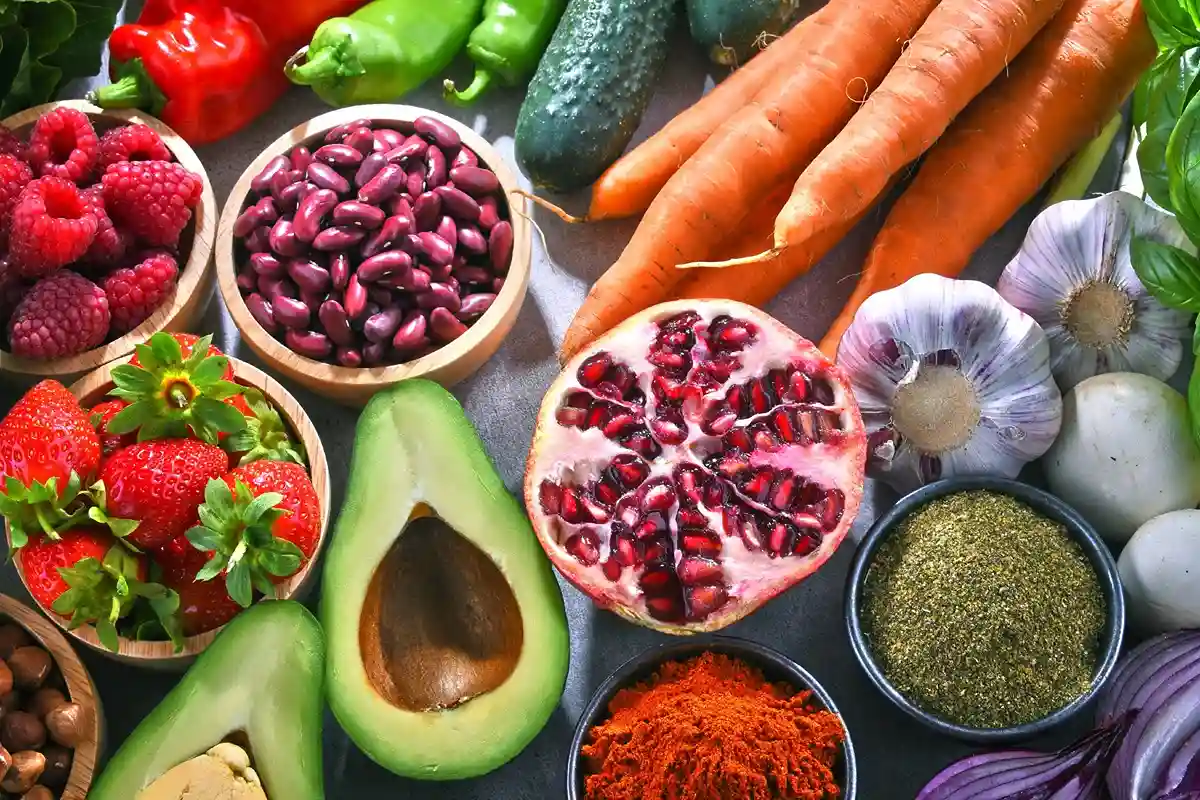Phytonutrients, sometimes referred to as phytochemicals, are naturally occurring compounds found in fruits, berries, vegetables, whole grains, beans, herbs, spices, nuts, legumes, and seeds. Essentially, phytonutrients help plants stay healthy in a variety of ways. Some classes of these compounds assist plants in fending off insect attacks and fungal infection, while others are skilled at protecting plants against radiation from UV rays and other environmental threats.
Article at a Glance:
Phytonutrients
- Naturally occurring in fruits, veggies, and more
- Protect plants from various environmental dangers
- There are likely tens of thousands of phytonutrients in nature
Flavonoids
- Contribute colorful pigments to various fruits, veggies, herbs
- Flavonoids boast robust amounts of antioxidants
- Various studies show that flavonoids contribute to longevity
Carotenoids
- Highly studied carotenoids include beta-carotene, lycopene, lutein, zeaxanthin
- Lutein and zeaxanthin are being studied for their ability to aid in vision health
Ellagic Acid
- Found in various berries, ellagic acid has proven useful in skin health
- Ellagic acid could aid specifically in repairing sun-damaged skin
Resveratrol
- Found in grape skins and red wine, resveratrol is thought to give red wine its heart-healthy characteristics
- It is a potent source of antioxidants, and numerous studies say that resveratrol helps protect the brain and the heart
Glucosinolates
- Found in often strong-smelling veggies, glucosinolates protect your cells from oxidative damage
- Studies found glucosinolates useful in the prevention of serious conditions, along with providing cardiovascular protections
Responsible for the color, flavor, and odor of plants—think the red hue of strawberries, the bitterness of kale, and the pungency of garlic—phytonutrients also provide protective health benefits reach beyond those delivered by vitamins and minerals. With antioxidant and anti-inflammatory properties, phytonutrients boast a host of health benefits to your body. But when you delve deeper into phytonutrients, you find that these compounds can zero in on specific physiological processes like your immune system, cardiovascular system, nervous system, vision, and more.
The sheer number of phytonutrients is staggering, as science has identified varieties of the compounds numbering in the tens of thousands, with more likely yet to be discovered. Since listing every single one along with its potential health benefits would require what is possibly the longest blog in Internet history, we thought it smarter to cherry pick the most intriguing phytonutrients and examine the richness, vitality, and healthy applications of these compounds of a different color.
Flavonoids Go To Work On Free Radicals
You metabolize each individual phytonutrient in unique ways, offering varied health effects across different parts of your body. One of the most studied groups of phytonutrients are flavonoids. Currently, there are an estimated 10,000 different members of the flavonoid family that contribute to the colorful pigments of various fruits, veggies, and herbs.
Classes of flavonoids include flavones, flavonols, and isoflavonoids, with each of those bearing their own subclasses. One of the chief talents of flavonoids, like most phytonutrients, is their ability to act as antioxidants, scavenging free radicals before they can inflict oxidative damage on tissues and cells. And since such harm can wreak havoc across your entire body, guarding against it is an important defense against a wide swath of ailments. In fact, a 25-year study in the Archives of Internal Medicine found that flavonoid consumption could be associated with a decrease in a number of conditions relating to longevity.
More specifically, a 2002 study found that men and women with higher levels of quercetin—a type of flavonoid found in red wine, onions, green tea, apples, berries, and Ginkgo biloba to name a few sources—had lower rates of cardiovascular events.
As for brain health, the anti-inflammatory and antioxidant powers of flavonoids could protect against cognitive decline. One promising study found that elderly men and women with the highest levels of flavonoids had a 50 percent lower risk of developing degenerative brain conditions.
Meanwhile, a Danish study from this year supports the potential longevity aptitude of flavonoids, as it followed thousands of participants for more than 20 years—with the results demonstrating that a moderate, habitual intake of flavonoids is associated with the avoidance of certain negative health conditions.
Seeing The Light With Carotenoids
Carotenoids are another type of phytonutrient with their own set of subgroups and benefits, with the most studied carotenoids including beta-carotene, lycopene, lutein, and zeaxanthin. While carotenoids have antioxidant powers similar to those of flavonoids, it’s their prowess with vision health in particular that makes the compound intriguing.
Lutein and zeaxanthin—carotenoids found in the lens, retina, and macula of your eyes—are generating interest among researchers, as they could potentially decrease the likelihood of age-related macular degeneration and cataracts.
The carotenoids lutein and zeaxanthin work to prevent oxidative stress on your eye’s lens, easing any damage caused by the “blue light” emitted from your smartphone and computer.
Ellagic Acid Influences Healthy Skin
Another class of antioxidant phytonutrient compounds is ellagic acid, which is mostly found in a host of berries. Ellagic acid has proven to be an effective way to combat wrinkles, with a study from 2010 showing positive results of ellagic acid on the inflammatory responses of skin cells under UV exposure.
Sunshine is great for soaking in vitamin D, but exposure over long periods of time can lead to a variety of skin conditions and a general less-than-stellar glow. Ellagic acid could potentially repair sun-damaged skin and treat age spots, as demonstrated by a 2013 study in the Journal of Cosmetic Dermatology. The study involved 82 participants, with a portion of the subjects given ellagic acid and another group administered a common skin-care ingredient. The ellagic acid group displayed a higher occurrence of even skin tone, decreased spot size and intensity, and an overall improved pigmentation, without any skin irritation.
Resveratrol: The Well-Known Antioxidant That You Might Not Know About
Belonging to a class of polyphenic compounds called stilbenes, resveratrol is found naturally in grape skins, peanuts, red wine, various berries, and the Japanese knotweed plant. The key source in the previous sentence is red wine—you see, for years resveratrol was the reason red wine was touted as being “heart healthy.” And the antioxidant everyone was referring to in red wine? That was resveratrol.
All fads come to an end and the drunken excitement surrounding resveratrol might have sobered up a bit, but that doesn’t change the fact that the compound is still a potent source of antioxidants. Let’s start at the top with your brain. Research has associated resveratrol with slowing down or even preventing certain types of cognitive deterioration. Specifically, spatial learning and memory, which are vulnerable to the effects of aging, were shown in an animal study to be aided by resveratrol’s neuroprotective antioxidant properties.
Meanwhile, a human study in 2017 demonstrated that resveratrol could markedly decrease neuro-inflammation—giving hope for research into the brain-potency potential of resveratrol to continue for years to come.
As for resveratrol’s effects on your heart, the cardiovascular health benefits of grapes and red wine are demonstrated in a 2011 study that administered weekly doses of resveratrol to overweight men and postmenopausal women. The results indicated a positive increase in blood flow, thereby easing blood pressure.
Nothing Bitter About the Healthy Aroma Of Glucosinolates
Steamed broccoli, sautéed kale, and roasted Brussels sprouts might be banned from your office microwave due to their pungent odor, but these cruciferous vegetables do a whole lot more than attack the olfactory senses of your cubicle neighbors. Thanks to the sulfur-containing compounds called glucosinolates, the foods that are far too often pushed to the side of your dinner plate could very well prevent a host of serious conditions.
The process of eating these specific group of veggies breaks down the glucosinolates within into compounds called metabolites, which control your metabolism and set in motion the antioxidant processes that protect your cells from damage.
Along with potentially lending a hand in preventing a series of serious ailments, cruciferous vegetables with glucosinolates could provide benefits against cardiovascular conditions. In a 2011 study, researched followed 134,796 Chinese adults and analyzed their dietary intake, including the amount of cruciferous vegetables ingested. The study found that these veggies promote cardiovascular health and overall longevity. What’s more, data from another study showed that consuming veggies with glucosinolates helped reduce LDL-cholesterol (the bad kind of cholesterol).
Phytonutrients Protect The Plants That Protect You
The fruits and vegetables we eat are so healthy and good for us that they deserve a measure of protection to call their own. Phytonutrients provide that protection, while also delivering added nutritional benefits beyond that of the vitamins and minerals most of us know by heart. The volume of phytonutrients in nature might be daunting, but so are the elements in the world that look to do us harm. Phytonutrients provide safety in numbers









